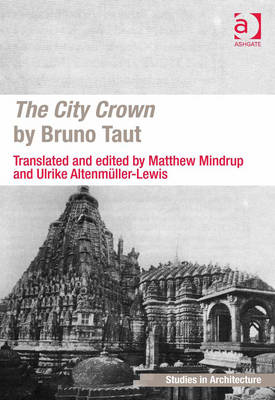This book is the first English translation of the German architect Bruno Taut's early twentieth-century anthology Die Stadtkrone (The City Crown). Written under the influence of World War I, Taut developed The City Crown to promote a utopian urban concept where people would live in a garden city of `apolitical socialism' and peaceful collaboration around a single purpose-free crystalline structure. Taut's proposal sought to advance the garden city idea of Ebenezer Howard and rural aesthetic of Camillo Sitte's urban planning schemes by merging them with his own `city crown' concept. The book also contains contributions by the Expressionist poet Paul Scheerbart, the writer and politician Erich Baron and the architectural critic Adolf Behne.
Although the original German text was republished in 2002, only the title essay of The City Crown has previously been translated into English. This English translation of Taut's full anthology, complete with all illustrations and supplementary texts, fills a significant gap in the literature on early modern architecture in Germany and the history of urban design. It includes a translators' preface, introduction and afterword to accompany the original composition of essays, poems, designs and images. These original texts are accompanied by illustrations of Taut's own designs for a utopian garden city of 300,000 inhabitants and over 40 additional historic and contemporary examples.
The new preface to The City Crown explains the premise for the English translation of Taut's anthology, its organization and the approaches taken by the translators to maintain the four different voices included in the original work.
Matthew Mindrup's introduction critically examines the professional and intellectual developments leading up to and supporting Bruno Taut's proposal to advance the English garden city concept with a centralized communal structure of glass, the city crown. Through the careful examination of original documents, letter conversations and previous scholarship, Mindrup locates crucial sources and provides insights into the reasons behind Taut's thesis. Where previous scholarship has sought to ascribe a single source for Taut's `city crown' concept to such diverse architectural and spiritual leaders as Fischer, Landauer, Nietzsche and Eckhart, Mindrup argues that it evolved in a more complex way. During the months immediately following the end of World War I, The City Crown proved a source of inspiration for Taut and his colleagues in the Arbeitsrat fur Kunst (Working Council for Art) who were seeking to develop a new post-war German architecture.
Ulrike Altenmuller-Lewis and Mark Brack's afterword introduces the English reader to Bruno Taut's life and career. The City Crown can be seen as turning point where Taut's social and spiritual agendas became fully equal to the pragmatic and aesthetic impulses found in his work. The text also introduces the reader to more recent (and largely German) research on Taut. These reconsiderations of Taut's theoretical work and personal development provide a fuller understanding of The City Crown's impact on Taut's career while placing the text more inclusively within the cultural landscape of the time.
- ISBN13 9781472422019
- Publish Date 28 August 2015
- Publish Status Active
- Out of Print 21 January 2022
- Publish Country GB
- Publisher Taylor & Francis Ltd
- Imprint Ashgate Publishing Limited
- Edition New edition
- Format eBook
- Pages 218
- Language English
